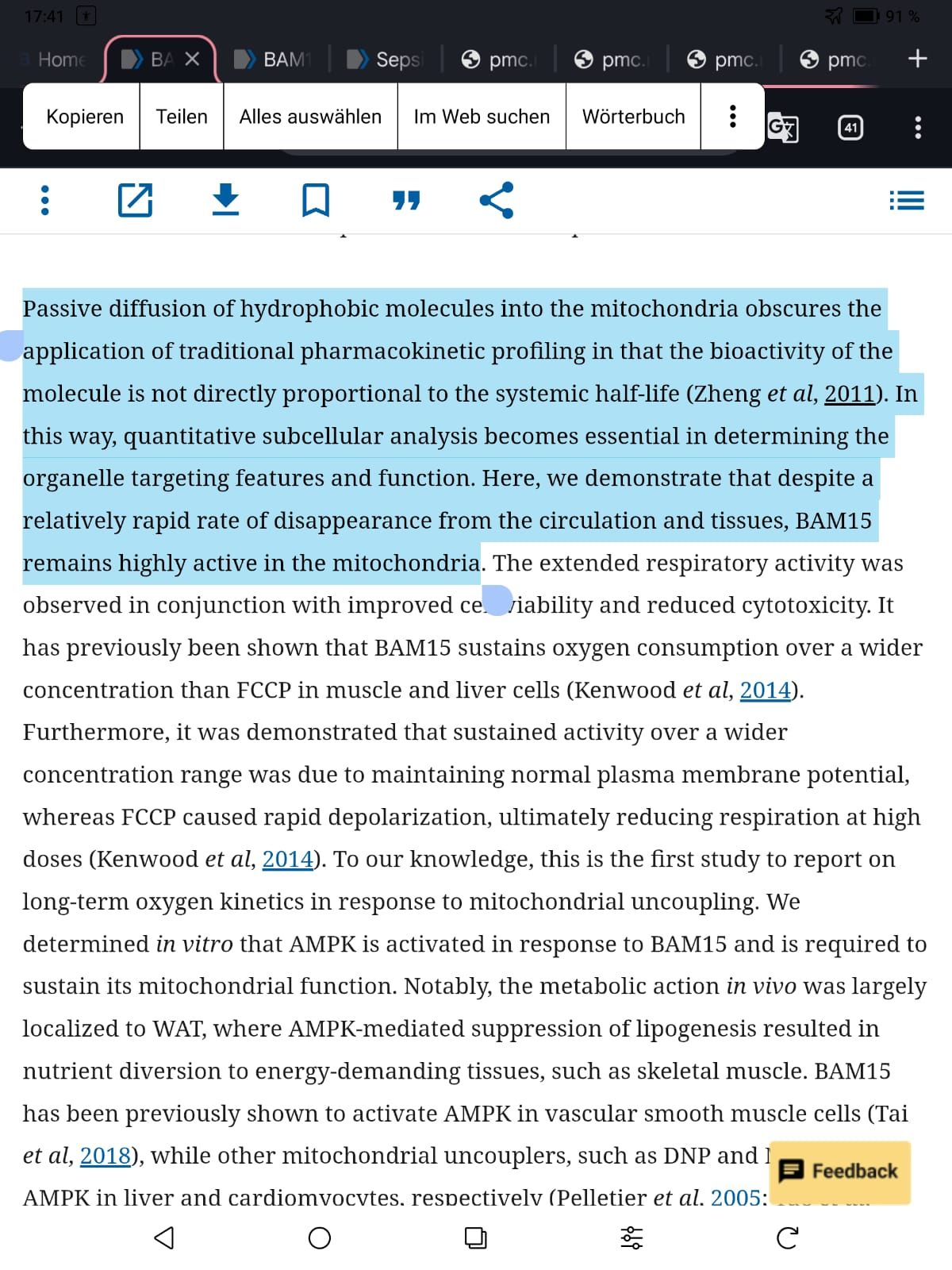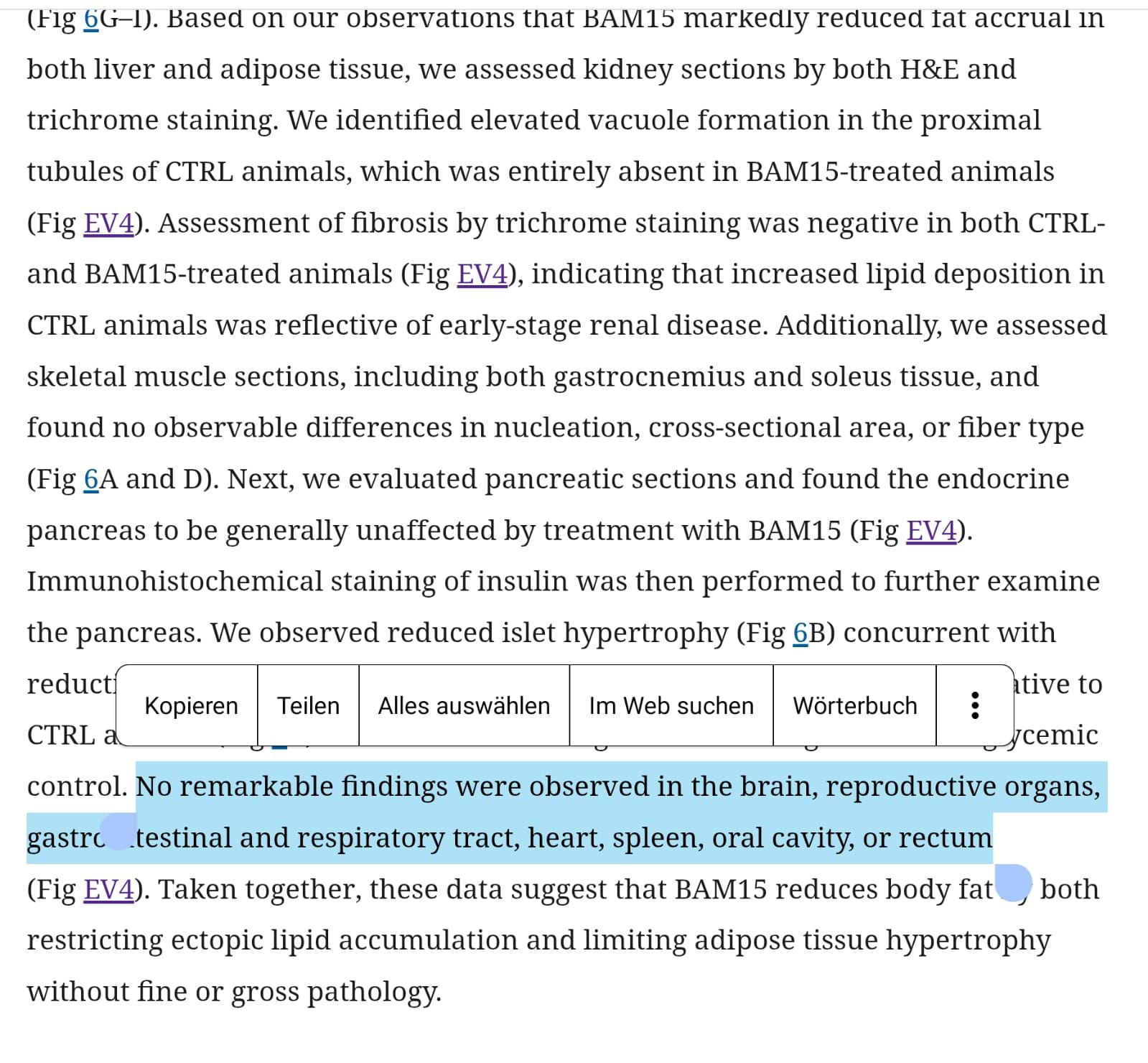Peaty uncoupler vs. Ozempic who wins ? New study.
-
@alfredoolivas nice thanks for the update.
I might actually do this. -
@alfredoolivas I ordered BAM15 a few days ago and if the tracking info is correct , it will arrive tomorrow already.
Not sure if I'll have time to try it right away since I'm still running another experiment, but maybe over the weekend I'll try a low dose.
-
@Mauritio yeah it’s a crazy shipping line they have running.
Are you referring to the DNP microdose? Amazing experimentation, may I ask what inspired you to pick 2mg as a dose or where I can find an explanation you previously gave?
-
@alfredoolivas Yes, you can find more on my X. Search for "DNP" on my site or look at my latest post on DNP in which I quoted a few other posts on low dose DNP (including the relevant studies). And there's more studies on microdose DNP that I haven't postet yet. One study shows reversal of ALS phenotype in mice for example.
I suspect that I've developed tolerance to the 2mg dose. So I'll probably increase the dose to 4mg and see if the benefits reappear.
-
Interesting thread @onliest
-
I received my BAM15 today (finally).
If someone wants to purchase half of it, let me know. -
Here BAM15 alleviated atherosclerosis by inhibiting the NLRP3 inflammosome.
The dosage was only 30mg (HED), so it seems low doses have benefits as well.
This was subcutaneous injectiom so you have to factor that in"BAM15 reduced atherosclerotic plaque formation, lipid deposition, and inflammation, and diminished mtROS expression and ox-mtDNA content in the AS mouse models. In both in vivo and in vitro experiments, BAM15 markedly inhibited the activation of the NLRP3 inflammasome, leading to reduced pyroptosis in endothelial cells. "
https://pubmed.ncbi.nlm.nih.gov/40393254/Here, BAM15 and a Trb agonist are more effective for treating fatty liver than each on their own. So combining BAM with sobetirome or just T3 should be good combo for the liver .
https://pubmed.ncbi.nlm.nih.gov/39152636/ -
@Mauritio said in Peaty uncoupler vs. Ozempic who wins ? New study.:
BAM down regulated SCD1 by almost 900-fold ! SCD1 concerts saturated fats into unsaturated fats and is implicated in many chronic diseases.
"...severe downregulation of sterol regulatory element‐binding transcription factor 1 (Srebf1 ; 490‐fold downregulated), carbohydrate‐responsive element‐binding protein (Mlxlpl ; 99‐fold downregulated), fatty acid synthase (Fasn ; 89‐fold downregulated), stearoyl‐CoA desaturase (Scd1 ; 898‐fold downregulated), adipose triglyceride lipase (Pnpla2 ; undetected in BAM15), and peroxisome proliferator‐activated receptor gamma (Pparg ; undetected in BAM15)”
I think this above part is very interesting. These down regulated factors all point to BAM lowering lipogenesis. It might even all be downstream from PPARg .
Fireinabottle writes about it here . Animals that lack PPARg remain insulin sensitive on a high PUFA diet and gain less weight. This happens because PPARg increased PDK4 which lowers pyruvate dehydrogenase. So lowering it will increase pyruvate dehydrogenase and enable you to burn sugar better.
In the study above on BAM15, PPARg was undetectable. -
I've seen people dose BAM15 several times a day due to its short half life, but this might not be necessary.
Since it's fat soluble, it stays active inside the mitochondria for a longer period of time.
On its safety:

https://pmc.ncbi.nlm.nih.gov/articles/PMC7338798/#emmm202012088-fig-0005ev
-
@Mauritio I wish the intracellular half life of substances was studied more
-
I have tried BAM15 at a dose of 25mg for 1 week.
I have lost about 600g in weight and my strength has increased. I was stuck at 8 pull ups for a few months and on my last day of taking it I increased the dose to 35mg and I was able to do 9 pull ups.
If my observation holds true, and there is some evidence for that in the studies I posted, than this will become VERY popular amongst bodybuilders. A safer version of DNP where you loose weight and maybe even increase strength ?!
The first 4-5 days I had a lot of bile dumps, what seems to be candida. I have noticed the same with DNP. Maybe uncoupling somehow helps the liver/ gallbladder somehow to excrete fungi.
I also noticed from day 1 that I felt warmer and my hands were slightly sweaty. Although measured ear temp didn't change.
I have stopped after a week because insomnia seems to have creeped up on me, but I'm not sure at all if it's even related because it's still there after I stopped.Overall those results are quite amazing given that a normal dose seems to be around 200-400mg and I noticed all of this from 25-35 mg.
-
@Mauritio
To me as an outsider those changes may be subtle fluctuations.
Wrt to the insomnia, could it be that your increased metabolism has depleted in some essential nutrient factor? Potassium or something of the wider B-family? Choline perhaps in the face of your reported biliary losses and what felt like increased liver turnover?
We need you to push on and report wrt to a consistent and sustainable trend over the short and medium-term : ). -
@CrumblingCookie I don't think so as the weight loss remaind after stopping. It might not sound like much but 600g per week is 2,4kg a month , that's pretty decent without trying hard.
That could be, I do eat like 6 eggs a week so I should be getting enough choline. But maybe the b vitamins are the issue or insomnia isn't related to BAM at all.
I'll maybe try 50mg over the weekend. i could also see myself using it weekly for the weight and liver benefits just to make if easier to maintain weight or eat more without gaining.
There is also an androgenic feeling to it.If you or someone else wants to try it, im willing to sell half of it to bring the cost down .
-
That could be, I do eat like 6 eggs a week
These are rookie numbers. You've got to pump these numbers up! You may need those 6 eggs = c. 900mg choline not per week but per every day! Go Go egg pudding!
Feeling initial benefits from substances until soon hitting a wall is easy. The art lies in figuring out and overcoming the latter. I, however, have more imminent priorities than upping metabolism rn.
-
I got insomnia from doing a high t3 cut… and it took a month or more to return to normal.
Have you tried upping your evening calories? Icecream before bed has healed me more than a lot of hacks out there.
-
@LetTheRedeemed Ice cream before bed might be a good idea yeah ..
-
@Mauritio it took me a while to find 2 brands that have no gums, however.
If you can’t find that, a higher fat milk with honey would also do the trick
-
@Mauritio I’ll be following how you recover from the insomnia. I hope to try it if it doesn’t sound too harsh on the sleep
-
For a moment I wondered why capsules with 50mg BAM15 are being sold much more expensively than capsules with the combination of BAM15 with SLU-PP-332 (an alleged exercise mimetic agonist of Estrogen receptor alpha, beta, gamma).
But upon a closer look, the SLU-PP-332/BAM15 are sold in micrograms (300mcg total, 50mcg BAM15). In contrast to the BAM15 in milligrams (50mg). -
"BAM15‐mediated restriction of bioenergetic efficiency prolongs life span and health span in Drosophila fed a ND or HFD. Improvements in life span and health span in ND were supported by synergistic enhancement of muscular redox capacity"